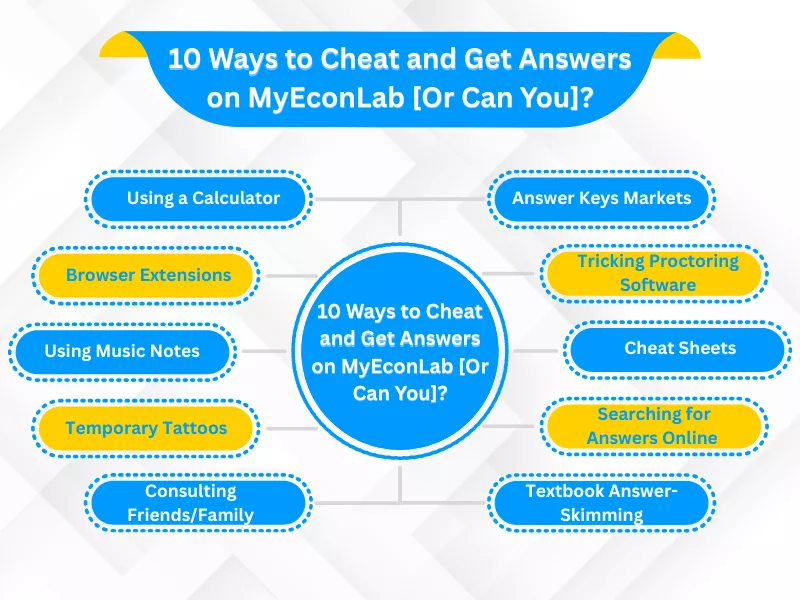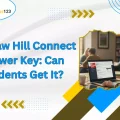Many students struggling with Pearson MyLab Economics think a shortcut will save them time. Some even try to cheat their way through—but the semester is much more than a few weekly quizzes. As academic helpers, we’ve seen how shortcuts backfire, leaving students overwhelmed and behind on deadlines.
Did you know over 15.1% of students drop out of Introductory Economics courses each year? Cheating doesn’t make things easier—it makes them harder.
So, what does help you excel in MyEconLab? Well, that’s the secret we are about to share today! This ultimate guide on How to Cheat on MyEconLab to Get Answers includes 10 viral cheating hacks, the ways instructors detect cheating, and how exactly you can get accurate answers quickly.
So, let’s begin!
10 Ways to Cheat and Get Answers on MyEconLab [Or Can You]?

Using a Calculator — marginal cost reduction
Did you know that a student created Clutchcalc only to cheat during exams? Why share this info? Well, you can use it too if your instructor allows calculators during exams, since it looks like a scientific calculator but can store images. Of course, you need to click the pictures of your notes or formulas to keep them handy. Therefore, you can now get answers quickly by solving them faster because the formulas are right in front of your eyes.
Browser Extensions — principal–agent moral hazard
The fun part is that, with the advent of AI, we can not only deepfake and pretend to be the hero of LA LA Land, but also get MyEconlab answers. There are so many browsers you can use to get answers quickly. These are powered by AI, and so even though there’s no guarantee that the answers will be correct (AI hallucinates, remember), you can meet your deadlines.
Using Music Notes — information asymmetry & adverse selection
Are you into music? Can you write musical notes? Well, then write the formulas in musical note format and keep them handy. Your instructor might be confused why you suddenly have musical notes beside, but at least you won’t lose precious time thinking of formulas.
Temporary Tattoos — innovation externalities / arms-race dynamics
Traditional books and classes may have been a thing of the past, but the cheating hacks do not necessarily have to be obsolete! Whether you are searching MyLab Econ or MyOpenMath Answers, you can use your hands, palm, or thigh as a board and write formulas there. So, when you feel stuck, a quick glance can help!
Consulting Friends/Family — peer externalities & reputational incentives
Have an economic junkei around? Maybe a friend or family member? Someone who aspires to become an economist? Well, connect them. Share your MyEconLab homework questions, and you can get answers without violating any code of conduct. After all, you are just taking help to finish your homework and technically not cheating or anything.
Though if your instructor is a Karen, they might misinterpret!
Answer Keys Markets — black market for information & network externalities
From Reddit threads and Discord channels to Quora and YouTube, you might find millions offering answer key sets for MyEconLab problems. For those who don’t know, you can get answer keys for questions online. Though these are not official answer keys from Pearson, they just solve the questions and share. Though one thing that confuses me is how exactly they get to know the questions beforehand; doesn’t the portal just randomize questions for each individual?
Tricking Proctoring Software — strategic adversarial behavior in dynamic games
When AI arrived, people thought it would replace them in their jobs, but here are our students tricking the AI-powered proctoring software most innovatively! The student faces the camera and pretends to take the exam, while a master of econ faces the screen and uses a laptop to take the test in reality. Well, can this be any more innovative?
As long as the teacher is tricked, it can work well, but!!! Well, you know the rest!
Cheat Sheets — information asymmetry, substitution effects & illicit information markets
Another interesting idea is to use cheat sheets! While you might not find EconLab cheat sheets online, you can create ones for yourself. Just write all essential formulas on a sheet and stick it to your screen. The camera cannot record your monitor’s screen. Then, at times, just calmly check those when the formulas evaporate from your mind!
Searching for Answers Online — low access costs & high elasticity of misconduct
Next, you can use the forums actually to post your questions and get answers. Plus, you can use LLMs like ChatGPT and Gemini to get answers by posting your questions in image or text format. Though double-check the answers, because they can give answers but might not know the exact format you should use. Some instructors specify the exact format and formula to use, which you might miss and end up getting no score even for a correct answer!
Textbook Answer-Skimming — substitution effect on human capital investment
Last but never least, you can open all resources and notebooks from Pearson MyLab Econ and use CTRL + F or Command + F to search for answers in the book. Just type the word from the question and get answers. Though you might miss your time limit, who cares? Well, instructors do!
Can Pearson MyEconLab Detect Cheating?
Let’s talk in detail!
How Do Instructors in MyEconLab Detect Cheating?

Proctoring Tools
One of the most important MyEconLab test tips is to understand how the proctoring software works because, boy, if your instructor uses one, there’s no way you can actually cheat and not get caught! The proctoring software:
Monitor Through Webcam & Microphone
They record (and sometimes live-stream) your video and audio during the exam.
- Detects if you look away too often
- Flags multiple people in the frame
- Picks up background noises (like someone whispering answers)
Screen Monitoring
They can record or mirror your screen activity.
- Tracks if you open new tabs or apps
- Detects copy-paste actions
- Flags switching windows or searching online
AI Behavior Analysis
AI tools analyze student behavior patterns.
- Unusual eye or head movement
- Long inactivity or sudden typing bursts
- Inconsistent typing style (if compared to earlier work)
ID Verification
Before starting, they often verify your identity using:
- Photo ID scans
- Facial recognition
- Sometimes, even keystroke dynamics (your typing rhythm)
Environment Scans
Some tools ask for a 360° room scan using your webcam to check for:
- Hidden notes or devices
- Extra monitors or people in the room
Scrambled Question
Remember when we talked about randomized questions? Let’s explain what it means. LMSs like Pearson MyEconLab come with an AI algorithm that tracks your progress and performance, so you get questions tailored to your skills and knowledge. Here, the one-size-fits-all approach doesn’t apply, and that’s how they empower self-paced learning.
Simply put, you and your best friend enroll in the same course. You spend 3 hours daily, and your friend spends 6 hours once a week. Evidently, you will quickly finish the assignments, and so you will level up.
When the tests come, even if you both have the same coursework, the same date, and the same instructor, the platform will give you questions as per your progress, meaning the questions will not be the same, so answer keys DO NOT WORK!
Performance Analytics
Now, this is where MyEconLab’s hidden economist comes into play — data analytics! Instructors get access to detailed performance reports that make it nearly impossible to “wing it” without being noticed, promoting effective learning on MyEconLab!
Detailed Activity Record
Every single click, scroll, and submission is logged. Instructors can see how long you spent on each question, whether you paused mid-problem, or if your activity pattern looks suspiciously inconsistent with your past behavior. If you finish a 30-minute test in five minutes flat — that’s a red flag waiting to wave.
Login Consistency Check
Think you can have a “smart friend” take your test? Think again. The system tracks your IP address, device ID, and even geolocation. Any unusual login — like suddenly taking your quiz from a new city or a completely different device — instantly raises suspicion.
Monitor Connection Logs
MyEconLab logs your connection history throughout the exam. So if you “lose internet” right when a hard question pops up and magically reconnect just in time to submit perfect answers, your instructor can see that too. These micro-disconnections often trigger audit flags in the proctoring report.
Common Answer Patterns
This one’s straight from the economics of probability — the more identical your answers are to another student, the lower the odds it’s a coincidence. MyEconLab’s analytics compare class-wide responses and flag statistically improbable similarities. Instructors can easily spot answer twins, especially on complex, multi-step problems where identical mistakes are too convenient to ignore. Though you can argue that you both followed the same MyEconLab exam preparation checklist, your instructor is no fool!
Now, doesn’t cheating seem like the most challenging task? If so, then check out the study hacks for MyEconLab and study diligently!
How to Find Correct Answers on MyEconLab Ethically: Tips to Solve MyEconLab Questions

Use practice mode first: Start by reviewing the learning objectives before jumping into any quiz or homework. Attempt questions in study mode before graded quizzes to understand the question patterns without the pressure of grading. Always remember — concept clarity matters more than speed.
Use Built-In Features: For those asking, “Are There Any Tools That Help in Understanding MyEconLab Concepts Better?” Use the “Help Me Solve This” feature to learn the logic behind each step. Always practice similar problems from your textbook or notes, as they often rephrase core ideas to support student success on MyEconLab.
Master graphs and formulas: Many MyEconLab questions are visual or formula-based — practice interpreting demand-supply shifts, elasticity, and cost curves.
Check time management: Set a timer to mimic test conditions so you’re not rushed during actual assignments using MyEconLab practice tests.
Review feedback carefully: Track your mistakes and revisit weak topics regularly to improve accuracy and confidence. After submission, read the solution explanations instead of skipping ahead — they often highlight the reasoning behind correct answers.
Though if you are a busy professional or a student attending multiple online classes, all this might seem time-consuming. That’s why most search for EconLab or Edmentum answers help online.
How to Pass MyEconLab Assignments?
Parting Thoughts,
Frequently Asked Questions
How Do MyEconLab Tests Work?
MyEconLab tests use adaptive algorithms that tailor questions based on your progress and performance. You get randomized problems, so no two tests are identical. The platform tracks your accuracy, timing, and patterns, ensuring a fair assessment while strengthening your grasp of economic concepts—not just rote memorization.
What Are the Best Ways to Study for MyEconLab Quizzes?
Focus on concept clarity over shortcuts. Revisit end-of-chapter questions, watch Pearson’s tutorial videos, and practice topic-specific exercises. Create quick summary notes for formulas, graphs, and key terms. Studying regularly — even 20 minutes a day — keeps you consistent and builds strong economic intuition before quizzes roll in.
How Can I Manage Time Effectively during MyEconLab Exams?
Time management on MyEconLab is all about pacing. Skim all questions first, start with what you know, and mark the tough ones for later. Avoid overthinking — each minute matters. Set internal checkpoints and keep an eye on the timer to stay efficient and calm throughout the test.
Alternatively, you can hire our experts when the clock is ticking!
Are There Any Tips to Get Correct Answers on MyEconLab without Cheating?
Yes — consistency beats shortcuts every time. Review past attempts, understand mistakes, and focus on application-based learning. Practice similar question types, keep notes on confusing topics, and use discussion forums for clarification. When you truly learn the logic, correct answers come naturally — no cheating needed!
- MyEconLab Homework Help: End Struggles and Achieve Top Grades - November 25, 2025
- Best Tips to Solve Online Class Imbalance Issues in 2026 - November 16, 2025
- How to Cheat on MyEconLab to Get Answers? - November 14, 2025











